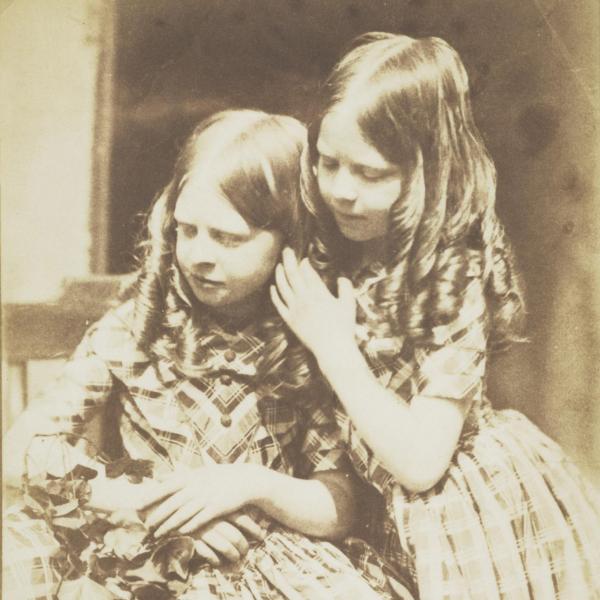Our new exhibition Scotland’s Photograph Album: The MacKinnon Collection showcases highlights from a 14,000-strong photography treasure trove jointly-acquired last year by the National Galleries of Scotland and the National Libraries of Scotland, with assistance from the National Lottery Heritage Fund, The Scottish Government and Art Fund.
The images, collected by photography enthusiast Murray MacKinnon, celebrate a century of Scottish life and identity and further cements Scotland’s significant placing in the history and development of photography. Highlights from the collection will go on display soon in concurrent exhibitions at the Scottish National Portrait Gallery and the National Library on George IV Bridge, the latter entitled At The Water's Edge. The collection is being digitised over the next three years and and will eventually be available to view online in its entirety.
In this feature, we take a tour of Scotland back-and-forth throughout the last two centuries, to reveal some of the best images in this remarkable collection…
We begin in the Central Belt, and in Scotland’s capital Edinburgh, with its illustrious architecture and interweaving wynds and closes. James Ross and John Thomson’s panorama reveals Edinburgh’s city centre as it looked 170 years ago. In the distance lies the Scott Monument, completed only a few years before, and the Royal Scottish Academy. The white space in the image’s centre is the grounds upon which the Scottish National Gallery would soon be built.

Some years ago, a Scot named Burns was fastidiously creating images of Scotland, though this was the photography of Archibald Burns rather than his renowned namesake, Rabbie. In his image, we are given a 150 year old glimpse into Edinburgh’s Cowgate and this photograph resides – along with many others – in his book Picturesque “Bits” from Old Edinburgh.
Moving away from the capital, George Washington Wilson captured what is arguably Midlothian’s crown jewel, the Rosslyn Chapel. Colour photography in the 1890s was difficult, labour-intensive and was largely uncommon aside from intrepid experimenters such as Wilson. His photochromic print of the 15th-century structure – since propelled into the limelight by Dan Brown’s The Da Vinci Code – pulled out the wonderful hues within the chapel’s stained glass. Wilson was a prolific photographer who captured a significant amount of Scotland. Many more of his images can be viewed here.
Across in Glasgow a half-century before, Thomas Annan was capturing haunting images of the city’s back-alleys and old closes. Annan is a key figure not only in Scottish photography but in the history of photography itself – more on him here – though is perhaps best known for his ghostly images of Glasgow’s overcrowded slums. His images, well-represented in Scotland’s National Galleries and National Libraries, are historical documents with an otherworldly air, conveying eeriness or unease, largely down to the technical issues of the period; the long exposure times produced ghost-like subjects in the photographs, if at all.
Glasgow’s long been known for its great depictions of children ambling around Scottish tenements, such as Oscar Marzaroli’s Gorbals photographs and those of Joan Eardley’s paintings, but thanks to the MacKinnon Collection, a newcomer into this fold is Dundee. An unknown photographer took some endearing images of Dundonian ragamuffins at the turn of last century, including these below.
Venturing further north, another unknown photographer caught brave folks standing precariously upon Aberdeen’s frozen-over River Dee back in 1885, whilst Linton M. Gibb fifty years later immortalized in print the city’s Mercat Cross with his dramatic shadow-laden image. This exact spot was, two centuries earlier, the subject to another dramatic scene, as the setting for James Stuart, AKA The Old Pretender, being proclaimed King James VIII.
Scotland’s Photograph Album is all-encompassing, containing vastly more incredible images and Scottish locations than space here permits, including of the Highlands, Fife’s Kirkcaldy, Cockburnspath in the Borders and Melfort in the West. But we can leap to the Islands to view the Birsay Cliffs at Orkney’s Skiba Geo, home to a mysterious whalebone sculpture. In John David Rattar’s image, someone sculls a rowing boat near unusually-shaped rocks, which frame the whole image.
Rattar also took an abundance of photographs in the Shetland Isles, including one similar to James Valentine’s A Peat Carrier, Lerwick, which documents the back-breaking work of islanders, in the bogs and moors, in the digging up and lugging of peat, a timeless fuel source or in some cases, flavouring of whisky. Valentine not only captured a truly staggering range of images of Scotland; he also converted his art into a profitable empire through selling these prints as picture postcards.
Lastly, our travels end in Moray, and with an image featuring associations synonymous with Scotland in the eyes of tourists across the world; tartan, the Highland games and malt whisky. An as-of-yet unknown photographer caught A. J. Stewart making his winning hammer throw 65 years ago whilst adorned in the Games’ traditional get-up, the tartan kilt. Reassuringly, whisky doesn’t feature here, however the image was taken in Glenlivet, home to world’s second most popular single malt. It’s an arresting photograph, with Stewart mid-swing. Caught is all the strain of the throw, and compositionally it’s near-faultless, with the eye deftly led from one side to the other, singing of movement – from here to there, from then to now.
Scotland’s Photograph Album: The MacKinnon Collection is now open at the Scottish National Portrait Gallery and runs until Sunday 16 February 2020.
At the Water’s Edge is now open at the National Library of Scotland, George IV Bridge, Edinburgh and runs until Sunday 16 February 2020.
The MacKinnon Collection was acquired jointly with the National Library of Scotland with assistance from National Lottery Heritage Fund, Scottish Government and the Art Fund.
















